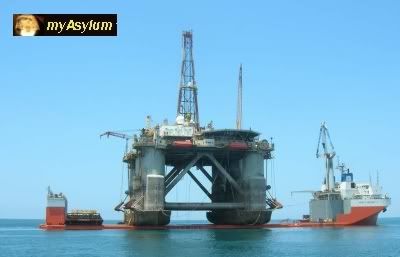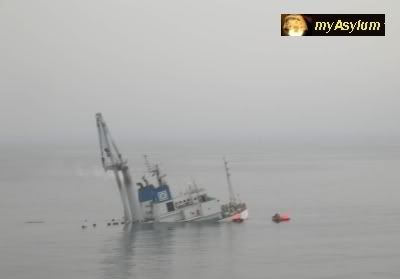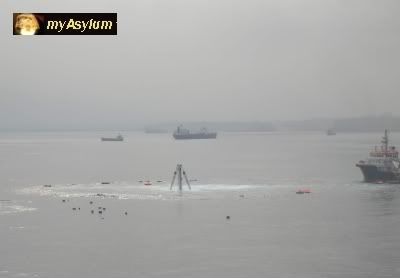The Semi-Sub that Couldn't
Technorati tags: Marine Vessels, Semi-Submersible, Mighty Servant 3, Aleutian Key, Sinking, Oil & Gas
Remember the children's story "The Little Engine That Could"? You do? Well, good.
Unfortunately this post has got nothing to do with it, except for the little wordplay on the title. Nor does it have anything to do with the Explosive Submarine Murder Scandal.
No, this post actually is about a semi-submersible marine vessel. Or semi-sub, for short. In particular it's about one called Mighty Servant 3, that recently sank off the coast of Angola.
 It came, it semi-submerged, then it decided to not come up... ever
It came, it semi-submerged, then it decided to not come up... ever
Being related to the Oil & Gas industry, Walski finds these occassional odd industry stories interesting. But first, a little low-down on what semi-subs are, and what does one like Mighty Servant 3 do.
(more semi-submersible banter, and pictures, in the full post)
There are various types of semi-submersible ships, which generally means that much of their bulk (or body) is submerged. Reef boats, where passengers get a view of the ocean while riding submerged, is one type, usually lumped in the "Tourist Underwater Viewing" category of semi-subs.
The Mighty Servant 3, on the other hand, is in the "Heavy Lift" category, and is used extensively in the Oil & Gas industry to transport floating cargo, such as mobile or semi-submersible drilling rigs, from fabrication yards to where the rigs are to be deployed, for example.
Heavy Lift semi-subs - or flo/flo (float-on / float-off) as they are commonly known - are able to lower its middle section to below sea level, allowing rigs, or even other vessels, to be positioned over the ship. The semi-sub ballast tanks are then emptied, causing the middle part of the vessel (called the well deck) to rise above water, thus supporting its payload. When discharging its payload, the reverse occurs - the ballast tanks are flooded, thus lowering the floating cargo onto the sea.
 The Aleutian Key atop the Mighty Servant 3 during deployment
The Aleutian Key atop the Mighty Servant 3 during deployment
According to the MarineLog.com report, the Mighty Servant 3 was deploying the drilling rig Aleutian Key, when the accident occurred, approximately one mile off the north Angolan coast, near Luanda. Fortunately, all of the crew escaped unharmed.
 The Mighty Servant 3 after developing a list and failing to resurface
The Mighty Servant 3 after developing a list and failing to resurface
The Aleutian Key, with 83 personnel on board, were all on the drilling rig when the sinking occurred, and no injuries were reported.
 The Mighty Servant 3 sinks further down the 60m depths
The Mighty Servant 3 sinks further down the 60m depths
Mighty Servant 3 is owned by Dutch heavylift specialist Dockwise, and is the second semi-sub owned by the company to be lost at sea, the first being sister ship Mighty Servant 2, which capsized on November 2, 1999, near the Indonesian island of Singkep. In that incident, 5 crew members perished.
 The Mighty Servant 3 is currently reported to be sitting at a depth of about 62m
The Mighty Servant 3 is currently reported to be sitting at a depth of about 62m
The Mighty Servant 3 incident occurred on December 6, 2006, and investigations are currently in progress to determine the cause of the mishap. Environmental concerns are also high, as there is always a risk of fuel leakage in accidents such as these. However, in the MS3 case, no fuel spillage has been reported.
In Malaysian waters, however, most platform jackets and topsides are transported using crane-equiped barges, and Walski has never actually seen a semi-sub up close. The closest to a lifting exercise that Walski has witnessed personally was about 10 years ago, when the ExxonMobil gas platform Lawit A was being loaded onto trasport barges. You'll probably never see a larger crane than the one Walski saw being used to lift the MSF (Module Support Frame) of one of ExxonMobil's larger gas platforms. The MSF is a single steel structure which sits on the jacket supports (the legs), and is used to support the production facilities which are assembled on top of it in modular form.
But who knows, in time to come, with less and less of the really large platforms being deployed, and more of the re-deployable offshore drilling and production facilities being put into service, we may see flo/flo's being used in the Malaysian O & G industry.
Hopefully ones that manage to stay afloat more...
















